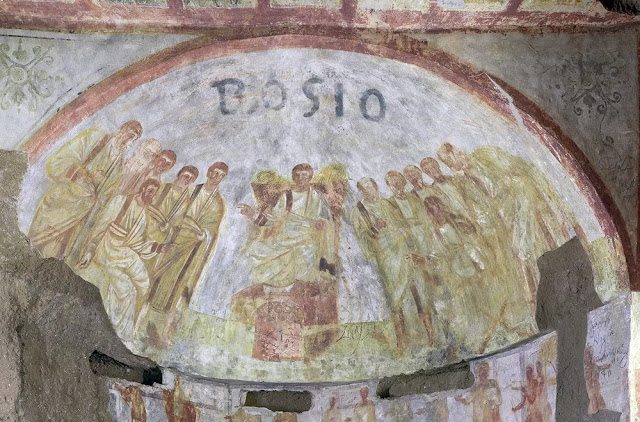Rome is famously known for its catacombs and in point of fact there are some forty catacombs to be found around the Eternal City. These catacombs are all underground and could be easily missed by pilgrims as it requires venturing "outside the walls" -- for reason that there was an ancient Roman law banning burials within the city's limits. These burial chambers were used by many different people, Christian and non-Christian alike, beginning around the second century A.D., but of course, we know them especially in relation to being a place where popes and Roman martyrs were frequently buried. Aside from being important places of pilgrimage, the catacombs are also important as sites because they contain some of the earliest extant examples of paleochristian art and iconography dated from the A.D. 200-400 period. Here may be found everything from early Christian graffiti (testifying to the devotions of the early Roman Christians) to frescoes ranging from early Christian symbolism to depictions of personages and scenes from both the Old and New Testaments.
 |
| Christ, the Good Shepherd. Found in the Catacombs of Priscilla |
 |
| The three men of the book of Daniel thrown into the fiery furnace by King Nebuchadnezzar for refusing to bow down and worship his statue. Found in the Catacombs of Priscilla. |
 |
| Noah in his Ark with the dove returning the sprig of greenery. Found in the Catacomb of Ss. Marcellinus and Peter. |
The catacombs are also the home of one of the earliest preserved depictions of the Blessed Virgin Mary, dating to the first half of the third century. It depicts the Mother of God holding the Christ Child, with one of the prophets of the Old Testament pointing up to a star in reference to the Messianic prophecy.
 |
| The Madonna and Child. Found in the Catacombs of Priscilla |
The Catacomb of Commodilla contains one of the earliest representations of the bearded Christ, seen here on the centre of the ceiling with the Greek alpha and omega to either side.
Other depictions show a non-bearded Christ, such as this portrayal of Christ and the apostles, all wearing senatorial togas with Christ seated like a teacher/philosopher. This particular representation is found in the Catacombs of Domitta and dated to the fourth century.
The personages of Ss. Peter and Paul also loom large in the catacombs, both in art and in graffiti, most famously perhaps in these depictions from the Catacomb of St. Thecla dated to the fourth century:
Here too is another depiction of St. Paul, also taken from the fourth century, and depicted very much as a philosopher.
 |
| St. Paul from the Catacombs of Domitilla |
We will conclude our considerations with this stunning apsidal like image from the Catacombs of Domitilla, showing a beardless, seated Christ, surrounded by his apostles.
(If you are curious what the "Bosio" reference is, well, that was the -- regrettable -- addition of the Maltese scholar/explorerAntonio Bosio who re-discovered this catacomb.)

















